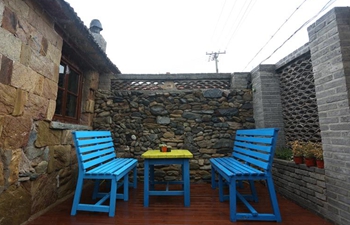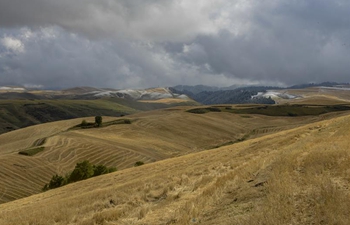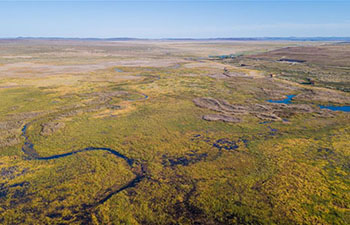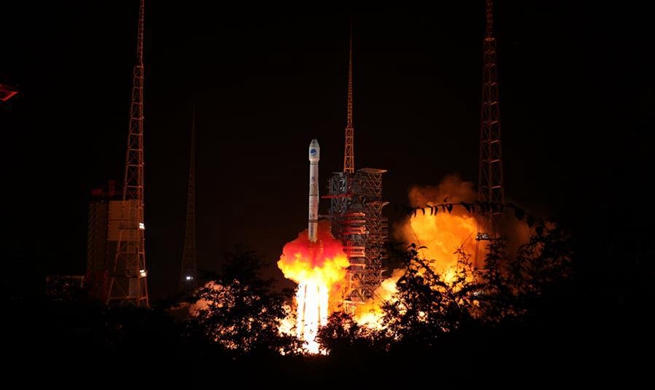By H. L. Bentley
YINCHUAN, Sept. 20 (Xinhua) -- Stewed lamb, meat falling from the bones. Bowls of steaming vegetables flash fried or doused in tangy sauce. Mounds of soft bread laden with tart pickled vegetables. Clear broths with red berries and slices of turnip. It was dinner time in Ningxia Hui Autonomous Region, and I had a feast laid before me.
Is there anywhere else in the world, where meal times are so symbolic, so ritualistic and so, frankly, confusing to outsiders, than China?
At the heart of Chinese meals, aside from the food, I think, is the satisfaction of taking time out: literal and figurative fulfilment after a day in the fields, time on the road, lives on the go.
The first time I visited Ningxia was to cover the role that education plays in poverty alleviation. I found a region at odds with my comfortable view of China. Life was hard. The earth itself was hard, the people harder still, bowed but not broken by hundreds of years of toil under the baking sun. For the younger generation, education really is the only path to a better life.
Ningxia was my first exposure to the so-called real China beyond the beautiful people and wide avenues of the capital. It brought home to me the inequality embedded in the world's second largest economy. It gave me insight into what may be the defining characteristic of all Chinese characteristics: perseverance.
Ningxia is home to just under 7 million people, a tiny place by Chinese standards. It is one of the driest places in China, surrounded on three sides by desert. In the sun-baked south, a year's rain would not fill an ordinary plastic bucket.
But even in the most extreme conditions, life finds a way. And Ningxia is no exception.
In China, there is a saying: If you move trees they die, if you move people they live on. From 2011 to 2017, 384,000 people in Ningxia left their ancestral homes to live in areas with greener land, better transportation and, crucially, more water.
Opportunity can be found in the most dire of circumstances, and for those fleeing the poverty of the encroaching desert, it presented itself in the form of an innocuous red berry.
The goji, or wolfberry, has been used in traditional Chinese medicine for more than 2,000 years. Today, products made from this super fruit, harvested in Ningxia, are exported across the globe, thanks, in part, to tens of thousands of people employed at goji farms, factories and distributors in the north of the autonomous region. The majority of those who rely on this northern industrial chain have been transplanted here from Xihaigu in the south, as uninhabitable as a place could be.
Ningxia can support this industry because of its fertile lifeline. The Yellow River is one of China's mother rivers. It passes through the green, productive land like an artery delivering oxygen to a beating heart.
Historically a transportation link, these days people and products need to get to their destinations quicker than floating along a lazy river, and that is why railways are so important to remote areas like Ningxia.
But, after a 10-minute romp up one particularity steep sand dune, I couldn't help but feel a sense of awe and disbelief. A railway had been built through this -- miles-upon-miles of sand dunes, some as high as 100 meters, and they move! How do you hold back the shifting sand? How can you tame such inhospitable land?
I did not have far to look for an answer. Under the sweltering sun, were around a dozen people, all paired up, one bent over a flat faced spade, the other laying down lines of dry straw. Together they made light work of the laying and digging-in of vast straw checker boards. These straw structures stretched as far as the eye could see and over time, play an integral role in helping tame the moving sand.
Never afraid to roll up my sleeves, I can wholeheartedly report that this is back-breaking work, and requires every minute of the midday rest the teams take in the hottest part of the day.
But while these people do battle with the desert under a cloudless sky, pockets of data move within a very different kind of cloud. Not too far away from these dry, sandy dunes, is a huge cloud service infrastructure complex.
Chances are, that if you live in Beijing, Shanghai or Shenzhen, your data will have been processed right here, in Ningxia. Amazon and domestic IT giants like 360 and Meituan all route some of their cloud services through this center.
A hot, dry region like Ningxia, on the surface, seems an unusual location choice for a server farm. But in true Ningxia style, the operators of this complex have made the conditions work for them. Rather than using water as a cooling agent, as in air conditioning, they use something which is in plentiful supply -- the wind that moves dunes!
The desert winds may not have changed in the year since I first came to Ningxia. But as I sat down to dinner, familiar faces regaled stories of the year's past achievements. The dusty air swirled in the early evening heat outside our comfortable air conditioned dining room. The familiar soundtrack of traffic punctuated the fluid conversation. I felt reassured, comforted even, by the warmth and optimism of the people that call this tiny, landlocked region home. It was dinner time, and, in this moment, everything was alright.

















